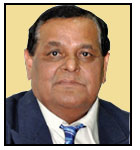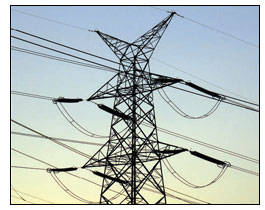 — S.C. Jha, Vice President &
Head, SBU - Transmission & Distribution, Tata Projects Ltd
— S.C. Jha, Vice President &
Head, SBU - Transmission & Distribution, Tata Projects Ltd
Tata Projects Ltd, part of the Tata Group, is amongst India's fastest
growing construction company. TPL has a diverse presence
spanning power, metallurgy, water, etc. In this exclusive interaction,
S.C. Jha elaborates on TPL's competency in the field of power
transmission & distribution. Whilst giving keen insights into the
1,200kV power transmission technology that India is heralding, Jha
asserts that the ongoing XII Plan period will unleash tremendous
business opportunities in power transmission. An interview by
Venugopal Pillai.
Indian power transmission is seeing increased involvement of
private sector under the PPP mode. What is your view?
Yes, Public Private Partnership (PPP) is the route that will be
increasingly used for setting up transmission projects in the
country. Government of India also issued a notification
on this in March 2011 and we expect that the PPP play will
go up in the coming years. Many states like Rajasthan and
others will also follow the PPP mode and this will increase
year on year.
How does the current order book of TPL's power T&D
business look?
We have a healthy order book and have one of the highest
shares in the T&D segment. In addition to the Indian market we
are increasing our focus on international markets and are
expect to get good order flows from here as well.
How does the order inflow in FY12 compare with that in FY11?
Order flow in 2011-12 has shown a good growth of over 40 per
cent as compared to the previous year.
Tata Projects has been dealing with several state power
transmission utilities. Do you see any change in their
procurement policies over the years?
No, we have not seen any change in the procurement policies
of the state power transmission utilities. However, as
mentioned above, many state power utilities are trying to
follow the PPP mode.
Tell us more about the Nagpur transmission tower
manufacturing facility of Tata Projects. Are you planning any
capacity expansion in the near future?
TPL set up a Tower Manufacturing Unit (TMU) near Nagpur to
meet the growing demand for transmission line towers. Our
TMU is approved by the Power Grid Corporation of India Ltd.
We have increased the manufacturing capacity in 2011-12 by
50 per cent from 24,000 tpa to 36,000 tpa.
 How is Tata Projects gearing to meet the demand of EHV
infrastructure like 765kV, 800kV etc?
How is Tata Projects gearing to meet the demand of EHV
infrastructure like 765kV, 800kV etc?
TPL is already qualified to participate and execute 800kV
towers in India. In fact, we have been executing several such
transmission line projects in India. Most of our projects are in
the 765kV and 800kV sector. Therefore, we are absolutely
geared up to meet this growing demand.
Please discuss the technical efficiency and also the potential
challenges of the new 1,200kV UHVAC technology that India is
heralding.
R&D efforts are on to augment the capacity of transmission
lines up to 1,200kV. The government has taken up a task to build
a test centre at Bina in Madhya Pradesh and set up a pilot
project to transmit 1,200kV power. Ability to evacuate more
power in a single line is of immense benefit. We think that this
is a good way to progress.
Currently, a test line of 1,200kV is being installed in Bina and
several tests are being conducted on the line. The country may
witness the commencement of 1,200kV transmission lines
being installed in some time from now.
The 1200kV line carries 6,000-8,000 mw power, which is very
high voltage. In case of any failure in transmission line
equipment, it disturbs the synchronization at grid and as a
result there will be a complete blackout in the region. The
performance of corona ring has to be highly efficient to avoid
electrical failure in the system. Test samples of such hardware
from reputed manufacturing companies in India are being
tested currently.
India will overcome the challenges of 1,200kV UHAVC
technology very soon.
What comes to your mind as the most challenging power
transmission project executed by Tata Projects in recent
times?
Tata Projects has been executing numerous challenging power
transmission projects and one of the recent one has been at Uri
in Jammu & Kashmir. The Uri-II line was executed at a very high
altitude and difficult terrain. We deployed very good and
dedicated workforce to head-load all transmission line
equipment to the tower locations. The line was constructed
during the winter season at sub-zero temperature.
What is your view on India's testing facilities in the field of
power transmission?
India has very good testing facilities both at the Centre and at
the state level for testing all transmission line equipment.
Further, advanced test facilities are also available on sites and
regional grids to locate the exact locations of failures, if any.
The power sector is believed to be facing severe shortage of
manpower. What is your view, and how do you work around the
situation at Tata Projects?
Manpower is a backbone for any organization to develop.
Manpower, both skilled and semi-skilled, is required in
sufficient number for majority activities of transmission line
(TL) projects. The TL project activities are such as casting
foundation, tower erection and stringing of lines. Usually,
manpower for casting foundations is available, but the number
of stringing gangs required for the projects is not many and this
is a great challenge for the T&D business.
Manpower required for the tower erection is passing
through a deep crisis. Tower erection gangs are available only
in West Bengal, Jharkhand and in some pockets of South India.
The number of such gangs is not growing because the
generation next is more interested to work for other
infrastructure projects such as roads and bridges than working
at heights for tower erection.
We are motivating all tower erection gangs by providing
them with good working environment, safety equipment and
statuary provisions such as PF, which is over and above their
normal compensation.
The XII Plan investment outlay in power T&D is expected to be
substantially higher than any preceding Plan period has seen.
How do you see emerging business opportunities in the coming
five years?
The country's current regional transmission capacity stands at
25,900 mw, out of which 11,800 mw has been added during the
XI Plan period. In the XII Plan period, Power Grid Corporation
of India Ltd has already earmarked an investment of Rs.1
trillion, nearly double the investment outlay of the XI Plan. The
XII Plan projects a total of 1,20,000 ckm (circuit km) of
transmission lines and 2,95,000 MVA transformation capacity
to be added.
The government has clearly articulated in its plan document
that it would supply power to every habitat of the nation, which
means that there will be more business opportunities for us in
the XII Plan period.